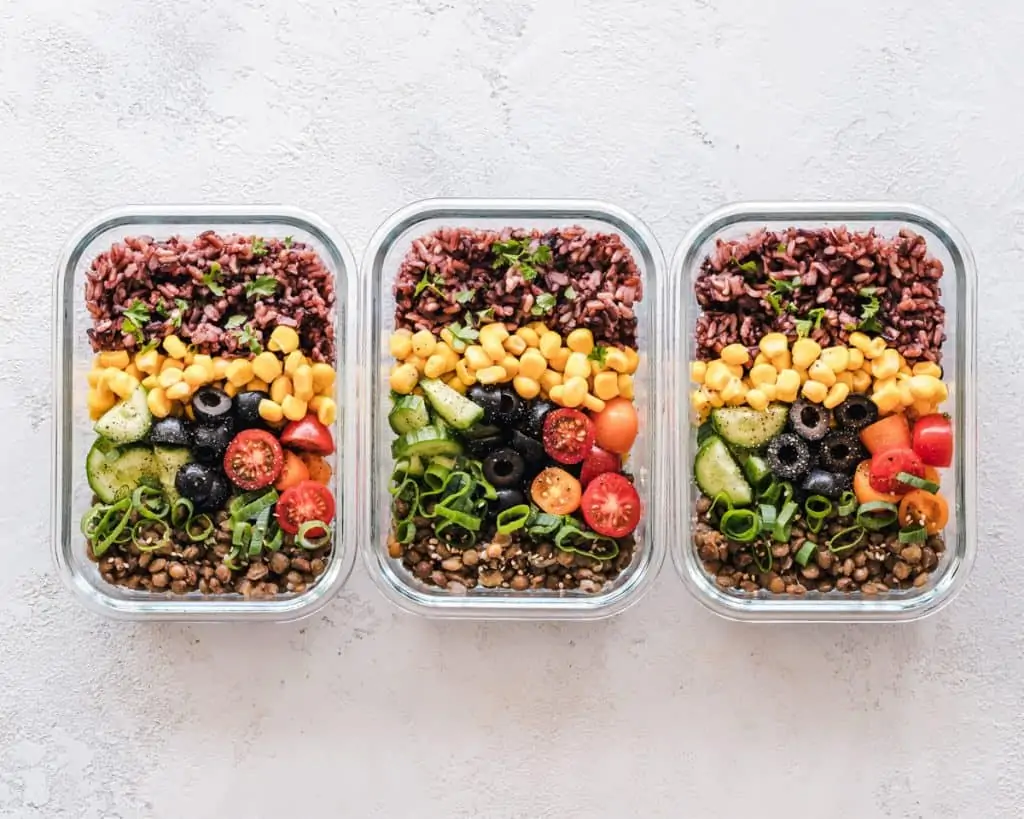Mindful eating is often suggested as a way to practice portion control.
But does portion control actually fit with mindful eating? This article will look at what portion control and mindful eating are and whether the two are compatible with one another.
What does portion control mean?
CW: this section contains a description of a dieting and disordered eating behaviour.
Put simply, portion control is a strategy to prevent overeating with the aim of weight loss or management.
It is thought that in controlling the portion, you are also controlling calories, fat, carbs etc and therefore controlling weight.
What are the hallmarks of portion control?
The ways in which people practice portion control include:
- Using smaller plates and bowls for food
- Using tall, narrow glasses for drinks
- Weighing and measuring out ingredients and food
- Never eating straight from a packet or bag
- Using a designated portion control plate
- “Crowding out” plates with lower-calorie foods in order to reduce the amount of higher calorie ones
- Avoiding buffets, family-style meals and shared meals
- Not allowing themselves to eat more than the allocated portion
- Packing away leftovers into individual serves straight away before sitting down to a meal
- Starting all meals with a glass of water (“filling up on water to leave less room for food”)
Note these are all behaviours that are designed to ‘trick’ the body or prevent us from eating freely.
What is the difference between portion size and serving size?
This is getting down into the minutiae but portion size is the amount of food that you choose to eat.
A serving size is the measured and standardised amount of food that is often declared on food packaging labels.
In reality, a lot of people would use portion size and serving size interchangeably and if they are practising portion control, might use the recommended serving size on a package to determine their portion.
What is mindful eating?
I have written a whole post about what mindful eating is and isn’t, but to quickly summarise:
Mindful eating is about focusing our attention, on purpose, on the act of eating, without judgement. It involves eating with awareness of our senses- our sight, sound, touch, taste and smell.
And among other things, it involves bringing awareness to our internal physical signals of hunger and fullness to help guide when we might start and stop eating (i.e. tuning into hunger and honouring fullness).
Why do people think portion control is part of mindful eating?
I get where portion control might seem like a legit way to eat mindfully.
It is because we more commonly associate ‘being mindful’ with ‘being careful’. If you look up the word ‘mindful’ in a thesaurus you will see that not only is ‘careful’ an associated word, but so are words like ‘cautious’, ‘apprehensive’, ‘vigilant’, and ‘wary’.
To think about ‘eating mindfully’ in this way suggests that food and eating has an element of danger about it.
Therefore, it sort of makes sense that being ‘careful’ with our eating might look like controlling portions or ‘watching what I eat’.
Alternatively, mindful eating is often offered up as a portion control strategy because there’s this idea that if you are present and more clued in to your body cues, you will stop eating at the precise point of fullness, not eating a bite more than you need, therefore saving on calories and supporting weight management.
But when it comes to the true meaning of mindful eating, portion control just does not belong.
Portion control is incompatible with mindful eating
Controlling your portions puts you in a position that does not allow you to be mindful of what is going on in your body.
It takes you out of your body and puts your focus and awareness on an external cue – the portion of food you have allocated yourself.
Portion control says that the amount you have allocated is enough – too bad if you are still hungry.
It totally disregards internal cues of hunger and fullness.
And ultimately moves you away from being connected with your body.
For all these reasons, portion control is in direct opposition to the true meaning of mindful eating.
Where might portioning support mindful eating?
With everything in life, there is going to be nuance and portion control and mindful eating is no different!
Rather than portioning food as a means to control calories and the amount of food eaten for weight management; when you are learning the skill of turning inward and connecting with the present moment, using a portion of food might be a helpful way to do this.
For example; to practice mindful eating, you may decide to put some chips in a bowl, rather than eat straight from the bag as a way to provide some containment around that experiment or practice.
And for people who experience binge eating, this may be a way to reduce anxiety about practising permission to eat a ‘trigger’ food with presence and connection.
The takeaway
At its core, portion control is a weight management strategy. Saying that it is a way to eat mindfully is diet culture in action, so be wary of anyone who is offering it as a part of a mindful eating practice.
Originally published April 2019.



 Hi! My name is Nina.
I’m a Certified Intuitive Eating Counsellor taking the ‘diet’ out of Dietitian. I am here to help you reject diet culture, tune into your body’s own inner wisdom about how to truly nourish yourself and ultimately feel good eating™
Hi! My name is Nina.
I’m a Certified Intuitive Eating Counsellor taking the ‘diet’ out of Dietitian. I am here to help you reject diet culture, tune into your body’s own inner wisdom about how to truly nourish yourself and ultimately feel good eating™ 

totally get this – lovely definition of mindful eating.
However – if someone has been habitually eating mindlessly whatever is on their plate, serving up smaller portions can help to kickstart the journey towards intuitive eating.
It doesn’t mean they can’t go back for more if they are still hungry – in fact it encourages them to keep tuning into their body.
A smaller portion also avoids that habitual ingrained ‘clean plate’ response that says waste must be avoided at all cost.
Thanks Lesley! I definitely don’t see portioning out your meal, having seconds or portioning out leftovers to be in the same realm as diet culture’s version of portion control which implies that portions must always be small and there is no flexibility with changing states of hunger, preferences etc.
I agree! If you’re mindfully eating, portion control should not be a thought popping up in your mind. Focusing on the taste and sensations as well as your hunger and fullness means that you’re free from judgment about the amount of food on your plate. Its hard to be mindful about how much food your body needs when you’re making portion sizes based on what diet culture is telling you is correct. Great post!
Exactly – agree with everything you have said here Kara. Thank you!
Such an important topic you’re shedding light on!
Thanks Liz 🙂
Such a hard phrase for some people to let go of, especially when it comes to the mindful eating piece of IE!
Yes, I am finding that already with the comments and questions that have popped up after people have read the post.